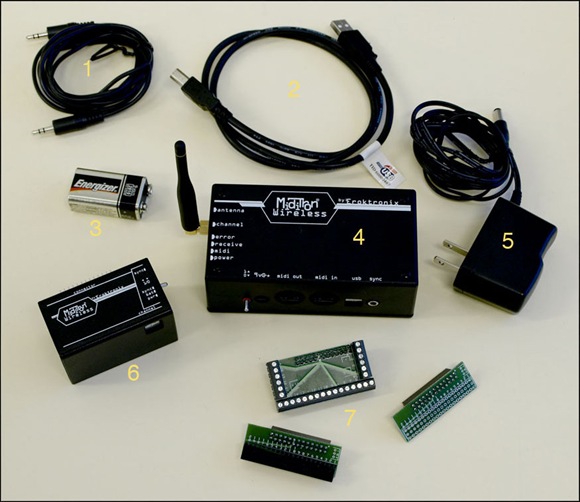Eric Singer, creator of musical robots and maestro of LEMUR, the League of Electronic Musical Urban Robots, has unveiled a new wireless sensor-to-MIDI interface. It’s quite a bit pricier than the non-wireless MIDI models at US$495, but the payoff is a complete kit for wireless performance that promises to be resistant to both latency and interference. The receiver can be connected via either USB or MIDI, and the sensor unit has 20 inputs which you can mix and match as up to 10 analog ins and 20 digital ins. Put the sensor/transmitter unit wherever you like, then transmit data wirelessly to the receiver — so the sensors could be strapped to a dancer while a computer or synth receives the data elsewhere.
I hope to have a hands-on demo soon, but in the meantime, here are the specs — just in case that wireless project can’t wait any longer.
- Small transmitter (2 5/8″ x 1 1/2″ x 1 1/2″); encloses internal antenna and 9v battery
- Can be worn on body
- 1000 foot range under ideal conditions; several hundred foot range possible even with obstructions
- Uses 900 MHz frequency band for less interference than the increasingly crowded 2.4 GHz band [Ed. What, you don’t like interference each time you microwave a burrito, really?]
- Uses highly reliable RF chip set proven in live performance situations
- Eight selectable channels allow eight units to be used simultaneously or channel switching if interference is encountered
- Continuous re-transmit of sensor values virtually eliminates drop-out or lost data
- Very low latency transmit (maximum 7 ms with all sensors enabled)
- Very low latency USB and MIDI output (actual latency system dependent)
- Normal (7-bit) and high (10-bit) resolution analog modes available
- Easily configured with menu-driven programming patch
- No network configuration required as with Bluetooth or WiFi
- Standard MIDI and USB-MIDI input/output ports
- With USB, appears on computer as a standard MIDI device with no special drivers required
- Once configured, can be used as a standalone MIDI device without a computer
- Several interchangeable styles of connector boards allow flexibility in making sensor connections
- Three-pin style connector board allows direct interfacing of popular sensors available from other manufacturers
If you still like wires, the US$149 original MidiTron remains an option (along with, of course, open hardware like the Arduino and such).
